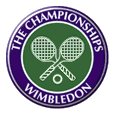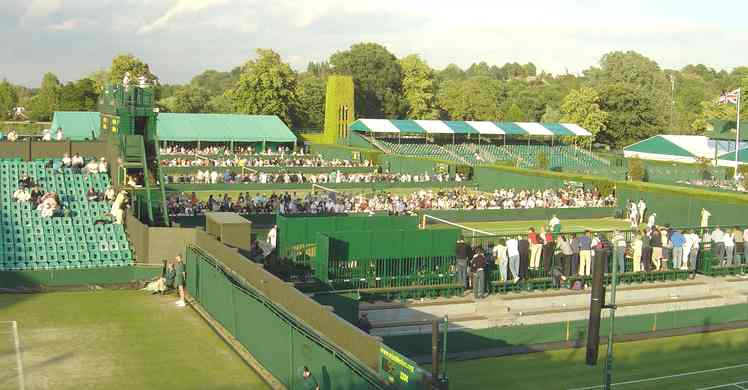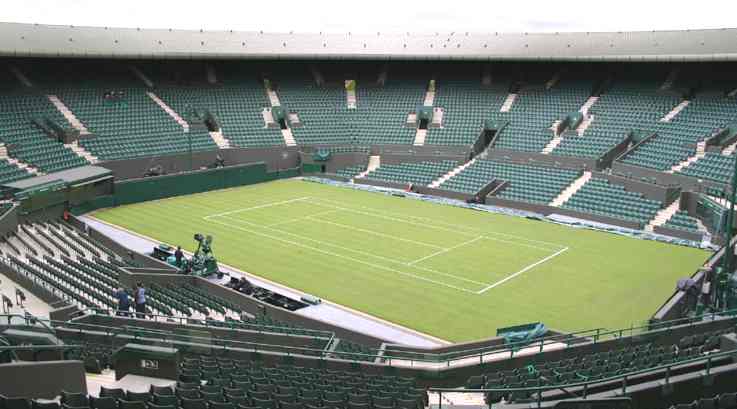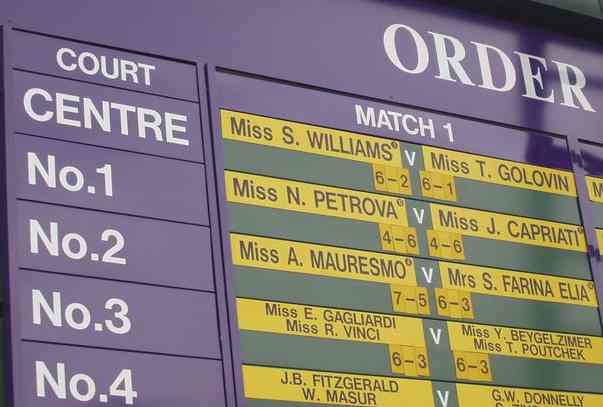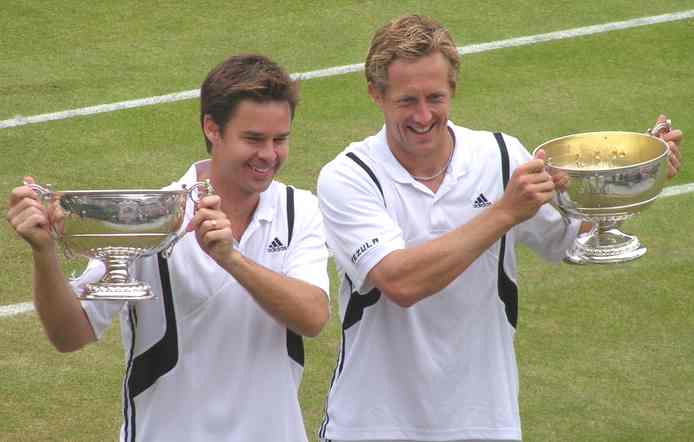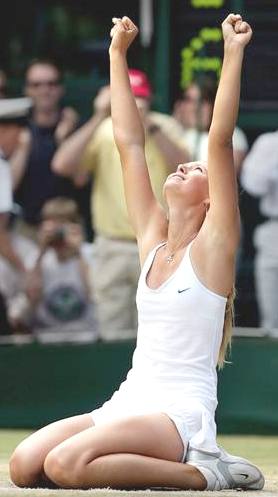|
WIMBLEDON
|
|||||||||||||||||||||||||||||
|
HOME | BIOLOGY | FILMS | GEOGRAPHY | HISTORY | INDEX | MUSIC | SOLAR BOATS | SPORT | SPONSORS |
|||||||||||||||||||||||||||||
|
The Championships, Wimbledon, commonly referred to as simply "Wimbledon", is the oldest and arguably most prestigious event in the sport of tennis. Held every June or July (starts 6 weeks before the first Monday in August), the tournament is the third Grand Slam event played each year, preceded by the Australian Open and the French Open, and followed by the U.S. Open. The tournament (which is the only one of the Grand Slam events played on grass) lasts for two weeks, subject to extensions for rain. Separate tournaments are simultaneously held for Gentlemen's Singles, Ladies' Singles, Gentlemen's Doubles, Ladies' Doubles and Mixed Doubles. Youth tournaments — Boys' Singles, Girls' Singles, Boys' Doubles and Girls' Doubles — are also held. Additionally, special invitational tournaments are held: the 35 and over Gentlemen's Doubles, 45 and over Gentlemen's Doubles, 35 and over Ladies' Doubles and wheelchair doubles.
Wimbledon Championships close of play 2004
History
The Championships were first played under the control of the All England Lawn Tennis and Croquet Club in 1877 at a ground near Worple Road, Wimbledon; the only event held was Gentlemen's Singles. In 1884, the All England Club added Ladies' Singles and Gentlemen's Doubles. Ladies' Doubles and Mixed Doubles were added in 1913. The Championships moved to their present location, at a ground near Church Road, in 1922. As with the other three Grand Slam events, Wimbledon was contested by top-ranked amateur players until the advent of the open era in tennis in 1968. Britons are very proud of the tournament but it is a source of national anguish and humour — no British man has won the singles event at Wimbledon since Fred Perry in 1936, and no British woman since Virginia Wade in 1977.
Events
There are five main events held at Wimbledon: Gentlemen's Singles, Ladies' Singles, Gentlemen's Doubles, Ladies' Doubles, and Mixed Doubles. In addition, four events are held for juniors: Boys' Singles, Girls' Singles, Boys' Doubles, and Girls' Doubles. (The Mixed Doubles event is not held at the junior level.) Finally, four invitational events are held: the 35 and over Gentlemen's Invitation Doubles, the 45 and over Gentlemen's Invitation Doubles, the 35 and over Ladies' Invitation Doubles, and the Wheelchair Gentlemen's Invitation Doubles.
Matches in the Gentlemen's Singles and Gentlemen's Doubles competitions are best-of-five sets; matches in all other events are best-of-three sets. Most events are single-elimination tournaments; in other words, a player who loses a single match is immediately eliminated from the tournament. However, the 35 and over Gentlemen's Invitation Doubles and the 35 and over Ladies' Invitation Doubles are both round-robin tournaments.
Each year, the tournament begins six weeks before the first Monday in August. It is held two weeks after the Queen's Club Championships, which is considered the major warm-up for Wimbledon for male players. Another important warm-up tournament for the men is the Gerry Weber Open, which is held in Halle, Germany at about the same time as the Queen's Club Championships. Wimbledon usually lasts for two weeks; the main events span both weeks, but the junior and invitational events are for the most part held during the second week. Traditionally, there is no play on the "Middle Sunday," which is considered a rest day. However, rain has forced play on the Middle Sunday thrice in Championships history: in 1991, 1997, and 2004. On each of these occasions, Wimbledon has staged a "People's Sunday", with unreserved seating and readily available, inexpensive tickets.
Players and seeding
A total of 128 players feature in each singles event, 64 pairs in each single-sex doubles event, and 48 pairs in Mixed Doubles. Players and doubles pairs are admitted to the main events on the basis of their international rankings. The Committee of Management and the Referee evaluate all applications for entry, and determine which players may be admitted to the tournament directly. The committee may admit a player without a high enough ranking as a wild card. Usually, wild cards are players who have performed well during previous tournaments, or would stimulate public interest in Wimbledon by participating. The only wild card to win the Gentlemen's Singles Championship was Goran Ivanisevic (2001); no wild card has ever won the Ladies' Singles Title. Players and pairs who neither have high enough rankings nor receive wild cards may participate in a qualifying tournament held one week before Wimbledon at the Bank of England Sports Ground in Roehampton. The singles qualifying competitions are three-round events; the same-sex doubles competitions last for only one round. There is no qualifying tournament for Mixed Doubles. No qualifier has won either the Gentlemen's Singles or the Ladies' Singles tournaments; in 1977, John McEnroe went farther than any other qualifier in history by reaching the semifinals.
No.1 Court
Players are admitted to the junior tournaments upon the recommendations of their national tennis associations, and, in the case of the singles events, on the basis of a qualifying competition. The Committee of Management determines which players may enter the four invitational events.
The Committee seeds the top players and pairs (thirty-two players in each main singles events, and sixteen pairs in each main doubles event) on the basis of their rankings. The defending champion is normally, but not always, seeded first. A majority of the entrants are unseeded. Only two unseeded players have ever won the Gentlemen's Singles Championship: Boris Becker in 1985 and Goran Ivanisevic in 2001. No unseeded player has captured the Ladies' Singles title; the lowest seeded female champion was Venus Williams, who won in 2005 as the fourteenth seed. Unseeded pairs have won the doubles titles on numerous occasions; the 2005 Gentlemen's Doubles champions were not only unseeded, but also (for the first time ever) qualifiers.
Grounds
The nineteen courts used for Wimbledon are all composed purely of rye grass. The speed and the low bounce of grass courts favours serve and volley players. Serve and volleyers such as Rod Laver, John McEnroe, Boris Becker, Stefan Edberg, and Pete Sampras have all won the Championships. However, baseliners such as Björn Borg have also performed very well, as have all-court players like Roger Federer. Among women, the serve and volley strategy is less common; one of the few female serve and volleyers, Martina Navrátilová, won Wimbledon on a record nine occasions.
The main show courts, Centre Court and No. 1 Court, are used only for two weeks a year, during the Championships. The remaining seventeen courts, however, are regularly used for other events hosted by the All England Lawn Tennis and Croquet Club. Wimbledon is the only Grand Slam event played on grass courts. At one time, all of the other Grand Slam events were played on grass. The French Open abandoned grass for its current red clay in 1928, while the U.S. and Australian Opens stayed with grass decades longer. The U.S. Open abandoned grass for a synthetic clay surface in 1975, and changed again to a hard surface with its 1978 move to its current venue. The Australian Open abandoned grass for a different type of hard surface in 1988.
The main court, Centre Court, was opened in 1922 when the All England Lawn Tennis and Croquet Club moved from Worple Road to Church Road. Due to possibility of rain during Wimbledon, a retractable roof is planned for the court; it is expected to be completed in 2009. The court has a capacity of almost 14,000; at its south end is the Royal Box, from which members of the Royal Family and other dignitaries watch matches. Centre Court usually hosts the finals and semifinals of the main events, as well as many matches in the earlier rounds involving top-seeded players.
The second most important court is No. 1 Court. The court was constructed in 1997 to replace the old No. 1 Court, which was adjacent to Centre Court, but was demolished because its capacity for spectators was too low. The original No. 1 Court was said to have a unique, more intimate atmosphere, and was a favourite of many players. The new No. 1 Court has a capacity of approximately 11,000. The third-largest court, No. 2 Court, has been dubbed the "Graveyard of Champions" due to its reputation as the court on which many seeded players have been eliminated during the early rounds. Famous players who have lost on the Graveyard during early round play include John McEnroe, Pete Sampras, and Serena Williams. The court has a capacity of about 3,000.
At the northern end of the grounds is a giant television screen on which important matches are broadcast. Fans watch from an area of grass officially known as Aorangi Park, but more commonly called Henman Hill. The "hill" takes its name from local favourite Tim Henman, whom many fans hope will become the first British man to win the tournament since Fred Perry did so in 1936. Due to Tim Henman's early exit and British newcomer Andy Murray's relative success in the 2005 Championship, the hill may be renamed as Murray Mound, Mount Murray, or Murray Field (after the Scottish rugby stadium).
Traditions
The order of play for all courts is displayed on boards around the grounds
Dark green and purple (sometimes also referred as mauve) are the traditional Wimbledon colours. Green apparel is worn by the chair umpire, linesmen, ball boys, and ball girls. The All England Club requires players to wear "predominantly white" clothing during matches. No other Grand Slam tournament has such a strict dress code for players. During matches, female players are always referred to with the title "Miss" or "Mrs". (Formerly, married female players were referred to by their husband's names: for example, Chris Evert-Lloyd appeared on scoreboards as "Mrs. J. M. Lloyd" during her marriage to John M. Lloyd. However, this custom has been abandoned.) On the other hand, the title "Mr" is never used for male players.
Previously, players bowed or curtsied to members of the Royal Family seated in the Royal Box upon entering or leaving Centre Court. In 2003, however, the President of the All England Club, HRH The Duke of Kent, decided to discontinue the tradition. Now, players are required to bow or curtsy only if the Queen or the Prince of Wales is present.
For the spectators, strawberries and cream is the traditional snack at Wimbledon. Approximately 28,000 kilograms of strawberries and 7,000 litres of cream are sold each year during the Championships.
Since 1992 Radio Wimbledon has broadcast commentary, speech and music from 7am to 10pm daily throughout the championship. It can be heard within a four-mile radius on 87.7 FM and also online
Trophies and prize money
The Gentlemen's Singles champion receives a silver gilt cup 18.5 inches (about 47 cm) in height and 7.5 inches (about 19 cm) in diameter. The trophy has been awarded since 1887. It bears the inscription "The All England Lawn Tennis Club Single Handed Champion of the World." The Ladies' Singles champion receives a sterling silver salver commonly known as the "Venus Rosewater Dish," or simply the "Rosewater Dish." The salver, which is 18.75 inches (about 48 cm) in diameter, is decorated with figures from mythology. The winners of the Gentlemen's Doubles, Ladies' Doubles, and Mixed Doubles events receive silver cups. The runner-up in each event receives an inscribed silver plate. The trophies are usually presented by the President of the All England Club, HRH The Duke of Kent, and by his wife, HRH The Duchess of Kent.
At Wimbledon, more prize money is awarded in the Gentlemen's events than in the Ladies' events. This is justified by the rules that men must win 3 out of 5 sets to win a match, whereas women only need to win 2 out of 3. The French Open also offered higher prize money for men until 2006, when it joined the Australian Open and the U.S. Open in offering equal prize money. In 2005 Wimbledon prize money exceeded £10 million (the exact amount was £10,085,510) in total for the first time. The sums awarded to the winners of each of the main events in 2005 are as follows (the amounts shown for the doubles events are per pair): 2005 Prize Money Summary:
Men's doubles winners, 2004
Champions
Records
External linksIn 1877, the All England Club held the first Wimbledon tournament, and its tournament committee came up with a rectangular court and a set of rules that are essentially the game we know today. The net was still five feet high at the sides, a carryover from the game's indoor ancestor, and the service boxes were 26 feet deep, but by 1882, the specifications had evolved to their current form.
LINKS:
WIMBLEDON LEGENDS
DOWN THE DECADES
ROLL OF HONOUR
CLASSIC MATCHES
Maria Sharapova
A - Z SPORTS INDEX
A taste for adventure capitalists
Solar Cola - a healthier alternative
|
|||||||||||||||||||||||||||||
|
This
website
is Copyright © 1999 & 2006 NJK. The bird |
|||||||||||||||||||||||||||||
|
AUTOMOTIVE | BLUEBIRD | ELECTRIC CARS | ELECTRIC CYCLES | SOLAR CARS |
